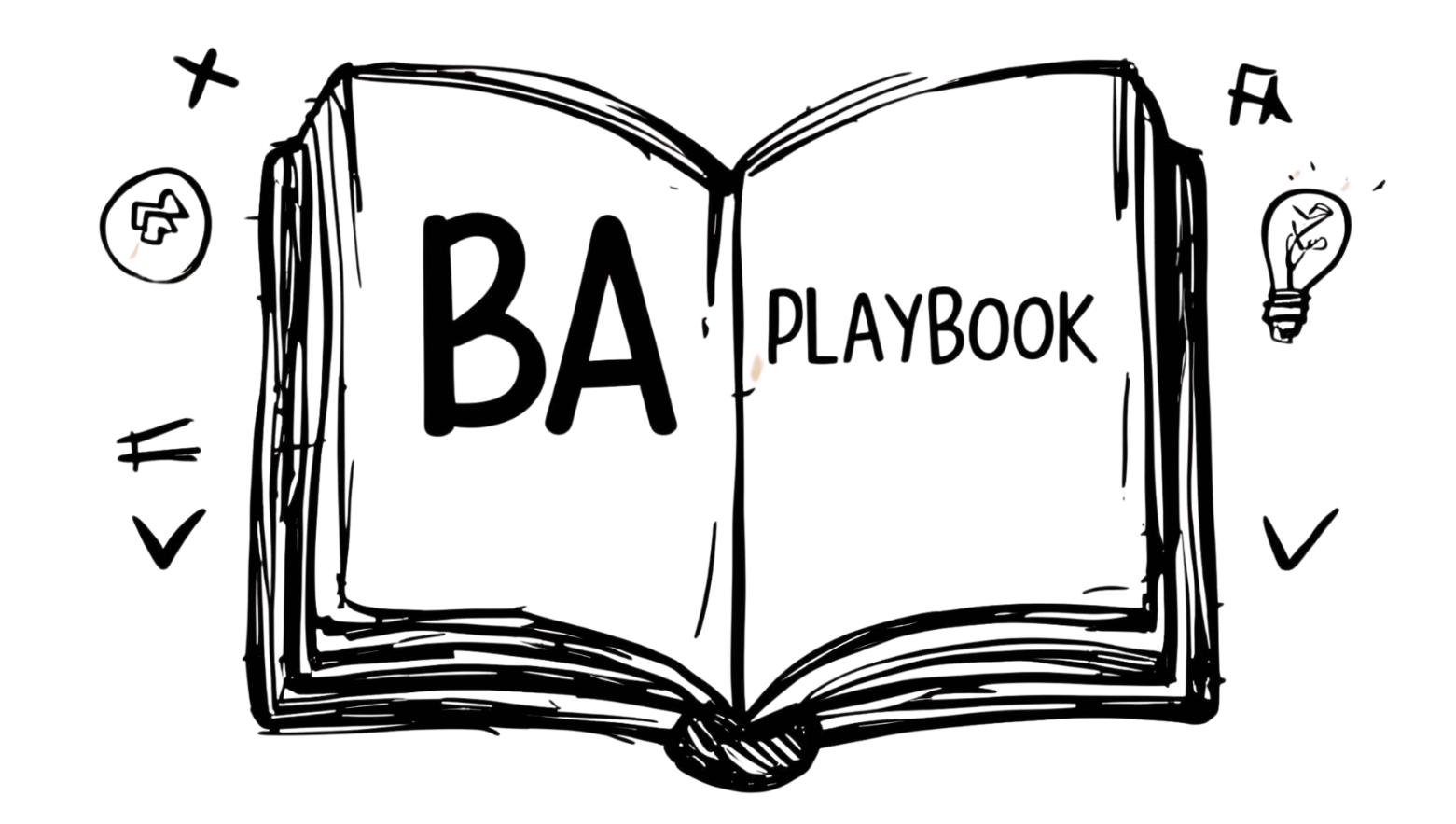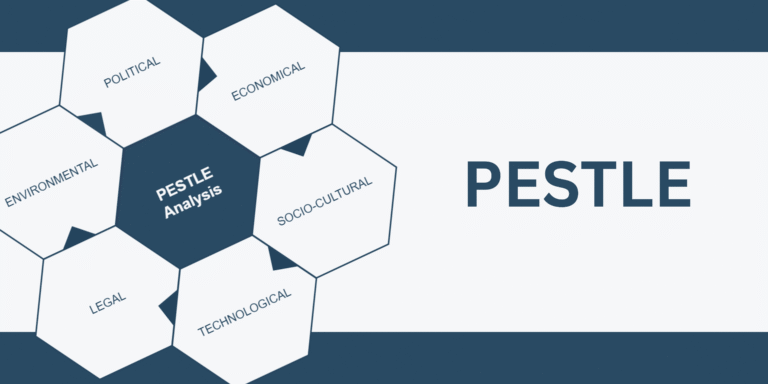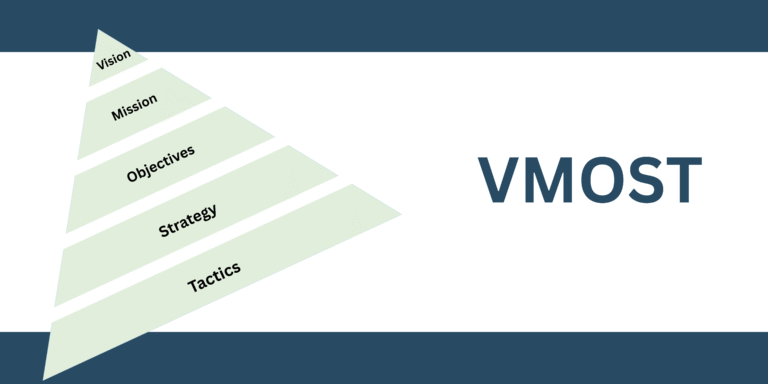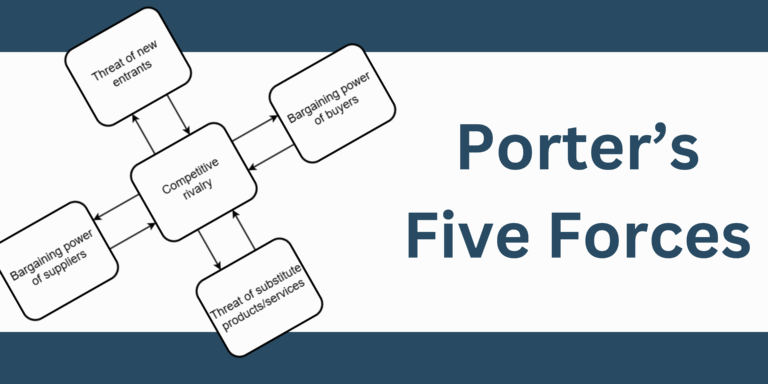Resource Audit Analysis: A Practical Guide for Business Analysts
If you’ve ever found yourself wondering, “Do we really have what it takes to pull this off?”. You’re basically halfway into a resource audit analysis without realizing it. Whether you’re evaluating a new business opportunity, planning strategic growth, or just trying to figure out why a team is stuck in second gear, a resource audit helps you take stock of your internal assets (and limitations). It’s like checking your toolbox before starting a major renovation – you don’t want to discover halfway through that you’re missing a hammer.
In this guide, we’ll unpack what resource audit analysis really means, how to do one, when to use it, and how to use AI to speed things up. You’ll also get real-life examples and a look at how this tool plays nicely with others like VMOST and SWOT.
What is a resource audit analysis?
A resource audit analysis is a structured way to identify and assess the key internal resources of a business or project. These resources can be tangible (like equipment, finances, or property) or intangible (like brand reputation, patents, or employee expertise).
Think of it as a business check-up—you’re figuring out what’s working for you, what’s holding you back, and what’s missing altogether.
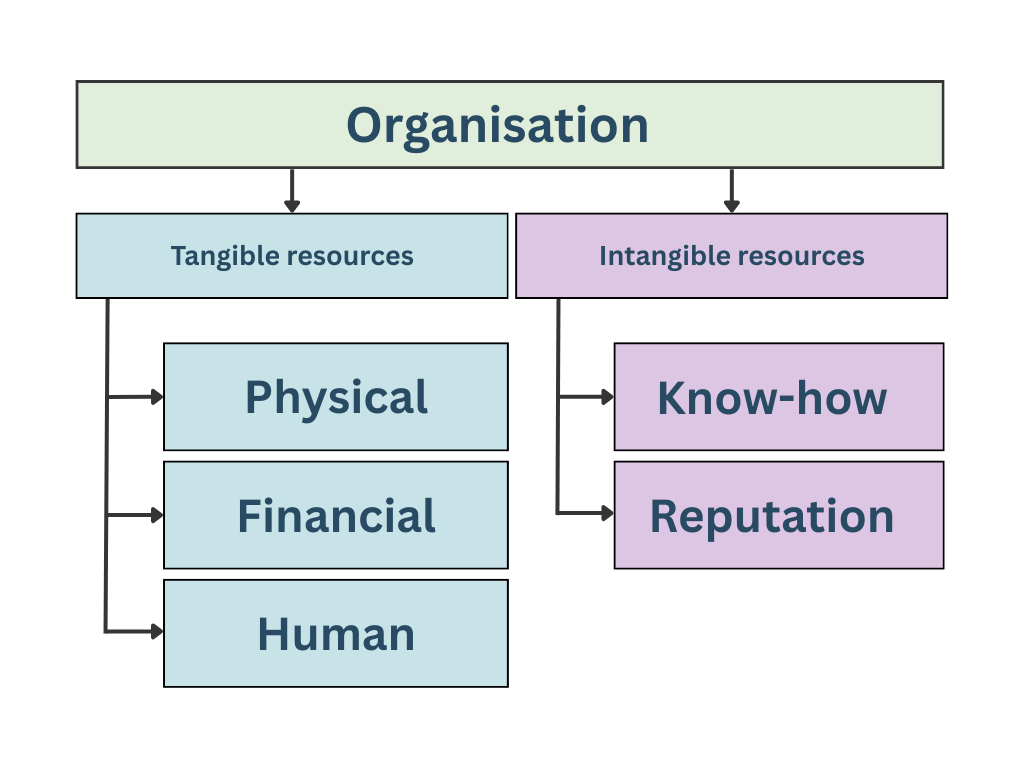
When is it useful?
You might want to conduct a resource audit when:
- Launching a new product or service
- Planning a strategic pivot or growth initiative
- Preparing for a SWOT or business transformation workshop
- Responding to competitive pressure or market shifts
- Conducting an internal performance review
In short, any time you’re making a big decision, this is your way to find out whether you’re bringing a butter knife to a gunfight…Or if you’re more prepared than you think.
Resource audit categories (with real-life examples)
Internal resources are generally classified into 5 categories: physical, financial, human, know-how and reputation. Each of them should ideally be listed as a source of strength or weakness, or both.
Here’s a breakdown of key resource categories you’ll want to assess during your internal resource audit, along with real-life examples to bring them to life:
1. Physical resources
This includes buildings and land, machinery, vehicles, tools, and any other physical equipment.
Example: A logistics company with a proprietary tracking system and 30 delivery trucks has strong physical resource backing compared to newer competitors.
AI Prompt:
“Create a physical resource inventory for a logistics company with regional operations.”Human Resources
2. Financial resources
This includes any financial assets and liabilities, cash flow, credit ratings
available cash, lines of credit, investments, and revenue streams.
Example: A startup that just closed a $2M seed round might have limited human resources but strong financial resources to scale operations.
AI Prompt:
“Summarize financial resources for a tech startup that recently secured Series A funding.”
3. Human resources
These are your people – their skills, knowledge, and experience.
Example: A mid-size consulting firm with senior analysts skilled in business transformation has a competitive advantage when bidding for government contracts.
AI Prompt:
“List the top 5 internal human resources in my team. Include specialized skills and certifications.”
4. Know-how
Patents, copyrights, trademarks, and proprietary software or methods fall into this category.
Example: A SaaS company owns a patented AI algorithm, making it hard for competitors to replicate its core product.
AI Prompt:
“List IP-based resources for a SaaS company with unique algorithms.”
5. Reputation
Customer trust, media visibility, social proof, and brand loyalty all fall under this intangible but powerful bucket.
Example: Think Apple or Nike—customers are loyal not just to the product, but to what the brand represents.
AI Prompt:
“Summarize brand-related resources for a company known for innovation and customer trust.”
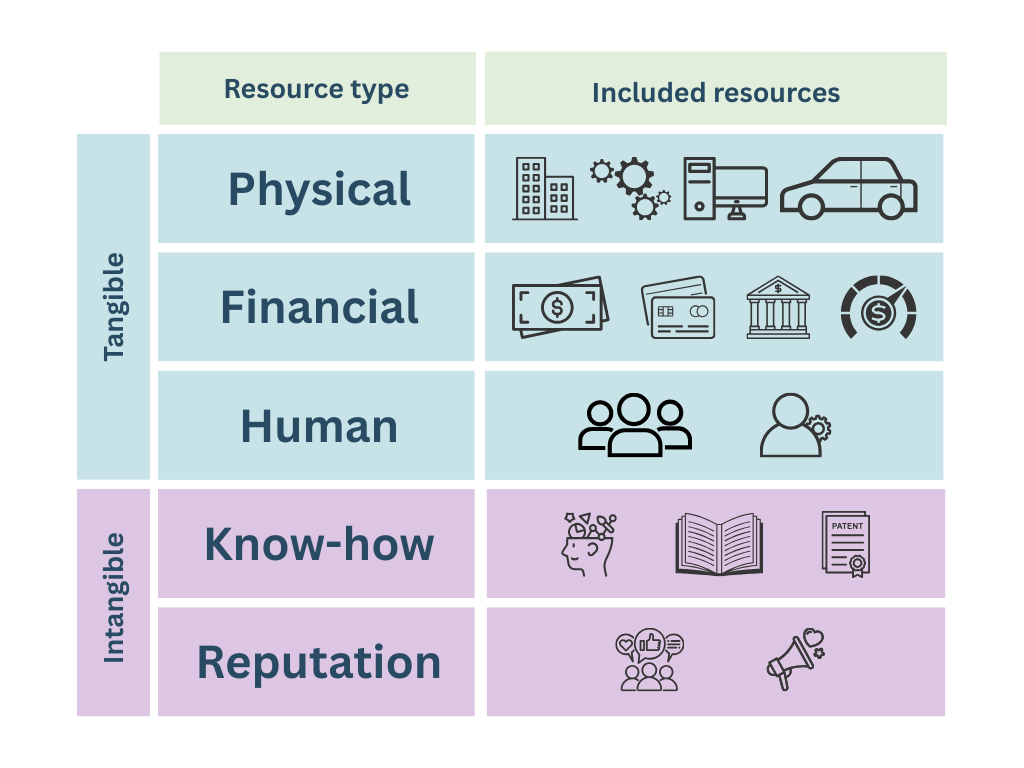
Advantages and disadvantages of a resource audit
Advantages:
- Clear internal picture: Know what you have and how to use it better.
- Better decision-making: Make choices based on capacity, not guesswork.
- Supports other tools: Great as a lead-in to SWOT, VMOST, etc.
Disadvantages:
- Time-consuming: Can feel like overkill for smaller projects.
- May overlook external threats: Focuses only on what’s inside.
- Bias risk: Team members may overvalue certain resources.
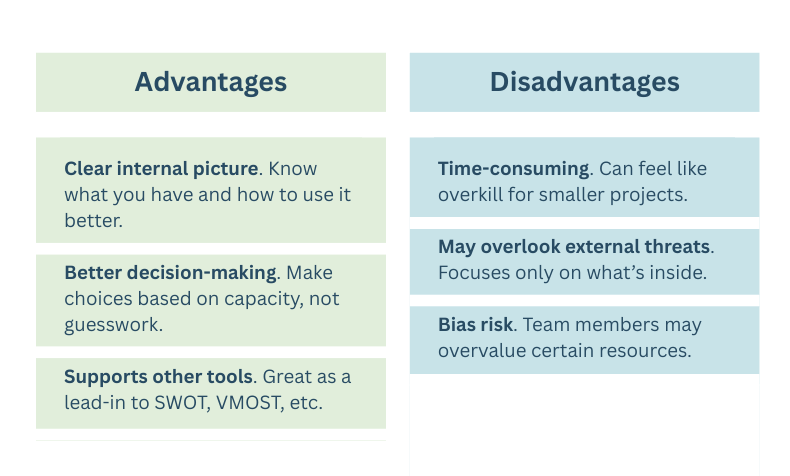
Related tools: where resource audit fits in
A resource audit analysis is often the first step in a broader strategic planning toolkit. Here’s how it connects:
- VMOST: Helps align your internal resources with your vision and strategy.
- SWOT Analysis: Resource audit feeds directly into your strengths and weaknesses sections.
- External analysis tools (PESTLE and Porter’s Five Forces): While a resource audit is internal, performing external analysis helps to obtain a broader view and assess the external pressures and complete the opportunities and threats in your SWOT analysis.
Pro tip: Use these tools together to get a full 360-degree view before making big moves.
Using AI to conduct a resource audit
You don’t have to do this all manually. AI can save you tons of time and give you fresh insights.
Here are some ready-to-use AI prompts for your next resource audit session:
Audit overview
- “Generate a categorized internal resource audit for a mid-size software firm.”
- “Summarize key business resources for a small e-commerce brand.”
Focus on intangibles
- “What cultural strengths might a startup with 10 employees have?”
- “Identify intellectual property advantages for a digital course creator.”
Gap-finding
- “Based on the listed resources, what gaps might hinder international expansion?”
You can use tools like ChatGPT or Claude to run these prompts and build a draft audit you can refine with your team.
How to run a resource audit (step-by-step)
- Choose your categories – note down the different resource types you will look at (human, physical, financial, know-how and reputation)
- Collect data – Pull from HR records, financials, customer feedback, and even Slack convos.
- Score or classify – Optional, but you can rate each resource as Strong / Weak / Underused.
- Review with stakeholders – Get input from different teams to balance the picture.
- Visualize it – A table or simple heatmap works well.
- Use it – Feed the insights into strategy sessions, SWOTs, or even investor decks.
Resource audit example
Here’s a simplified resource audit example for a small ed-tech company:
| Resource Type | Strengths | Weaknesses |
| Physical | In-house studio for content recording | No physical campus or offline presence |
| Financial | Moderate funding with healthy cash flow | No recurring revenue yet |
| Human | Skilled educators with tech backgrounds | Limited hiring budget |
| Know-how | Proprietary learning modules and quizzes | No formal patents |
| Reputation | Strong presence in niche educator communities | Low awareness among parents |
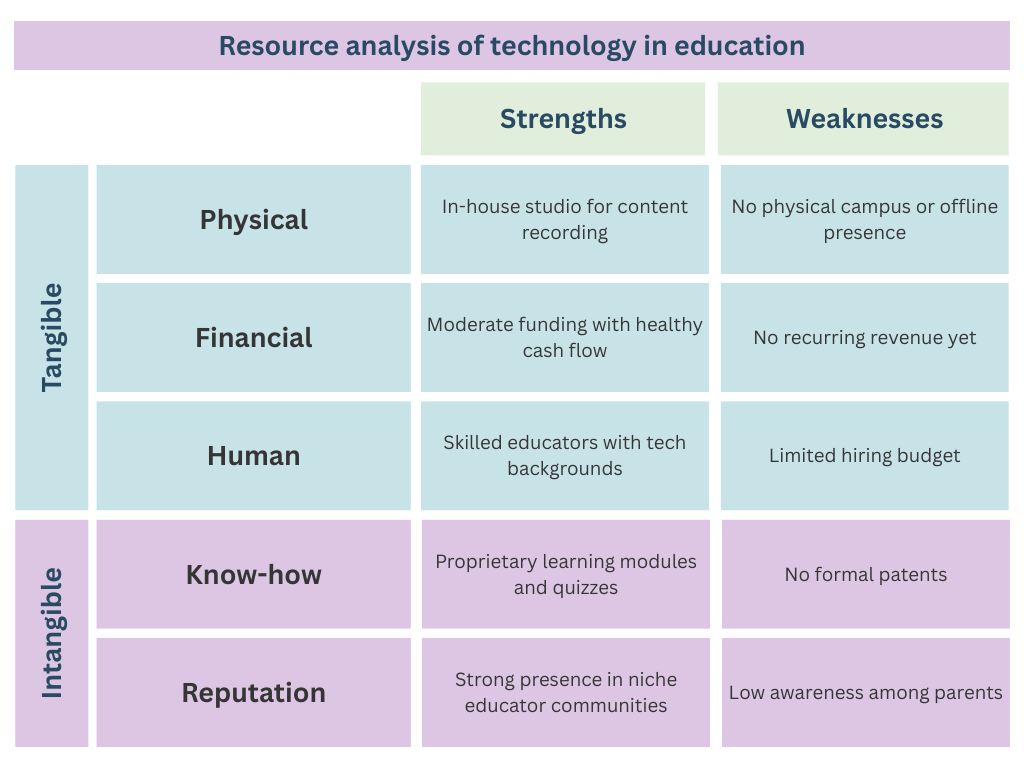
Wrapping up
A resource audit analysis might not be the flashiest tool in your business analysis kit, but it’s one of the most foundational. Knowing exactly what you’ve got (and what you don’t) is key to making smart, grounded decisions. Whether you’re pitching to investors, mapping out a new project, or just trying to make your team more efficient, a resource audit brings the clarity you need.
And now, with AI on your side, it doesn’t even have to take forever.
